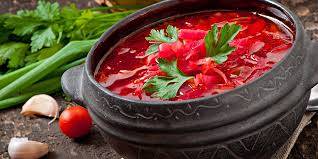Officials promise there will be no issues with the traditional vegetable set for borscht

Andrii Kravchenko, Deputy Director of the Department of Agricultural Development at the Ministry of Agricultural Policy and Food of Ukraine, emphasized that the area planted with all the vegetables in the borscht set has increased this year in Ukraine, ensuring citizens will be supplied. He clarified that this refers to the traditional vegetable set—potatoes, onions, carrots, cabbage, and beets.
According to the official, for the second consecutive year, the area of vegetable crops and the total harvest are growing, particularly in the Lviv, Vinnytsia, Cherkasy, Poltava, and Dnipropetrovsk regions. Therefore, he is confident that Ukrainians will have an adequate quantity of vegetables, and the prices for the borscht vegetable set will be somewhat lower than last year, making them accessible to consumers.
By the way, on the occasion of the Borscht Festival, which has been held in various cities in Poland for the third consecutive year, the analytical center Gremi Personal calculated the Borscht Index, which shows the cost of ingredients for making traditional Ukrainian borscht and serves as a specific indicator of the purchasing power of the population and the general price level for essential products. According to UNIAN, this year, the Borscht Index in Ukraine and Poland demonstrates significant differences due to varying economic conditions in both countries. As of August 2024, the cost of ingredients for making borscht in Ukraine amounts to 169.7 UAH. This index includes ingredients such as pork (300 g), beets (300 g), potatoes (300 g), cabbage (300 g), carrots (200 g), onions (200 g), garlic (50 g), tomato paste (70 g), sour cream (200 g), greens (40 g), and seasoning.
At that time, in Poland, a similar set of products for making borscht would cost almost twice as much – 306.9 UAH (29.02 zlotys). Therefore, this figure shows how accessible basic food products are for the average Ukrainian. Thus, despite the widespread myth that products in Poland are cheaper, Ukraine still remains a country with lower prices for essential food items. Of course, this is related to differences in the standard of living and average income of the population. Analysts also point out the discrepancies between the minimum and average wages in Ukraine and Poland. After all, in Poland, the minimum wage from July 2024 will be around 738 dollars – that is 4,300 zlotys gross, which is equivalent to approximately 3,060 zlotys after taxes. Meanwhile, in Ukraine, the minimum wage from April 2024 will be 200 dollars (8,000 hryvnias gross). Regarding the average wage, in Poland it is about 1,450 dollars (after taxes, this is around 6,000 zlotys), while in Ukraine it is approximately 580 dollars (21,800 UAH).
In fact, the Borscht Index shows the difference in the cost of living between Ukraine and Poland, but this does not mean that one country is definitively cheaper or more expensive to live in. A comprehensive approach should be taken into account for an accurate analysis, which includes all prices, incomes, and expenses, to understand the real picture of the population's well-being in each country.
It should be noted that recently the All-Ukrainian Agricultural Council has warned about the possibility of further price increases for food products. This is explained by the difficult conditions faced by Ukrainian agrarians. As stated by Deputy Head of the All-Ukrainian Agricultural Council Denys Marchuk, due to the potential return of power outages, producers will be using generators, which significantly raises their costs. The energy generated by these generators costs up to 30 UAH per kilowatt, making price hikes for products inevitable, he added. The Council representative also mentioned that among other factors contributing to the increase in food prices are the ongoing war, inflation, a lack of adequate labor supply, rising fuel costs, and occasionally unfavorable weather conditions. According to him, losses in the harvest of soybeans and sunflowers have already been recorded, which will reduce the supply of Ukrainian oilseed crops for export.
The loss of export potential for corn due to heat during the flowering period could reach 8-9 million tons, which will also force a reassessment of the overall export forecasts for agricultural products. All of this is likely to lead to a decrease in foreign currency earnings. As an example, it has been observed that there has been a constant increase in the price of bread in Ukraine for some time. A number of factors influence these prices. There is a likelihood that most bakeries will close, resulting in a low supply of products. Over the course of two summer months, the price of flour surged by as much as 50%, and this trend is expected to continue. Moreover, in addition to the rising costs of raw materials, expenses for electricity, logistics, packaging materials, and more are also increasing.
In this regard, it is worth mentioning the words of Taras Vysotsky, who noted that the deficit of electrical energy could affect the prices of a significant group of goods. The pessimistic scenario for entrepreneurs in the manufacturing industry predicts an additional 10% increase in costs. The optimistic scenario suggests an increase of 3 to 5% on top of current prices. The pessimistic scenario is based on calculations indicating that, due to restrictions, enterprises will almost always have to operate on generators, which means the production costs will accordingly rise. In contrast, the optimistic scenario of a 3-5% increase is based on the assumption that until the end of October, most of the time, enterprises will be able to operate with regular power supply connections.
 Found a mistake on the site? Tell us:
Found a mistake on the site? Tell us:

 Telegram
Telegram